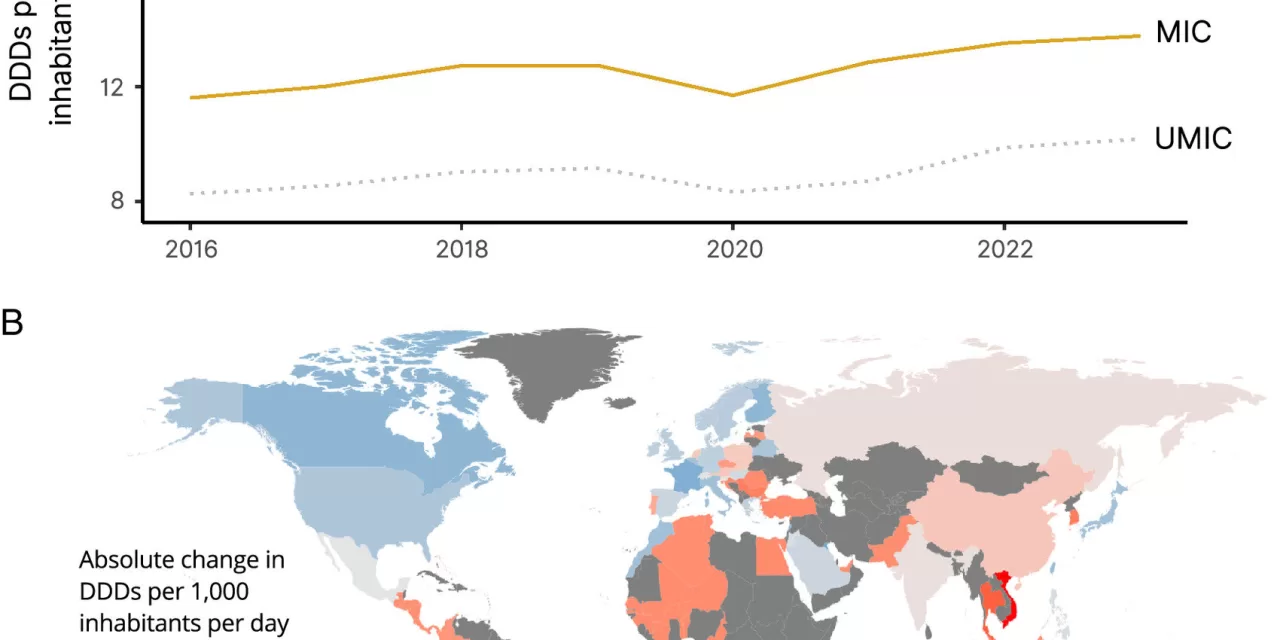A new study reveals that global antibiotic consumption has surged significantly since 2016, with potentially serious implications for antimicrobial resistance (AMR), a growing public health crisis. The study, published in the Proceedings of the National Academy of Sciences, examines trends in human antibiotic use across 67 countries from 2016 to 2023, shedding light on patterns of consumption, the impact of the COVID-19 pandemic, and projections for the future.
The Rise in Antibiotic Use
The research, led by Dr. Eili Klein of the One Health Trust, alongside partners from institutions like the Population Council, Johns Hopkins University, and Harvard T.H. Chan School of Public Health, found that global antibiotic sales increased by 16.3% over the study period. This rise translates to a jump from 29.5 billion defined daily doses (DDDs) in 2016 to 34.3 billion DDDs in 2023, reflecting a 10.2% increase in the overall consumption rate across the countries studied.
Before the pandemic, the trend varied by income level. High-income countries had seen a decline in antibiotic use, while middle-income countries experienced rising consumption. However, the pandemic disrupted this pattern, with significant reductions in antibiotic use in many nations, particularly in high-income regions. In fact, antibiotic consumption in these countries dropped by nearly 18% from 2019 to 2020, as the pandemic shifted healthcare priorities.
Middle-Income Countries Lead the Increase
Middle-income nations experienced the most substantial rise in antibiotic consumption, with several regions showing the largest increases. Over the period studied, middle-income countries consumed more “Watch” antibiotics—those considered to pose a higher risk for resistance—compared to the “Access” antibiotics recommended for general use. This shift raised further concerns about the future management of AMR, especially as these nations continue to see increased antibiotic use.
By contrast, high-income countries maintained higher consumption of “Access” antibiotics, although they too saw an uptick in overall antibiotic use. This global trend of increased consumption suggests that even in wealthier nations, the fight against AMR could be jeopardized if the use of antibiotics is not better controlled.
Pandemic Disruption and Recovery
The COVID-19 pandemic had a temporary impact on antibiotic consumption, with reduced usage as healthcare systems focused on managing the virus. However, the data indicates that antibiotic consumption rebounded quickly after the initial disruption, raising alarms about the continued overuse and misuse of antibiotics.
Dr. Klein emphasized that the pandemic’s disruption should not mask the larger, persistent issue of rising antibiotic use. “To address this escalating crisis, we must prioritize reducing inappropriate antibiotic use in high-income nations while making substantial investments in infrastructure in low- and middle-income countries,” Klein stated. Effective infection prevention, improved vaccination coverage, and better stewardship of antibiotics are key to tackling this challenge.
Projections and Future Concerns
Looking ahead, the study projects that global antibiotic consumption will increase by an alarming 52.3% by 2030, reaching a total of 75.1 billion DDDs. This projection highlights the urgent need for interventions to curb rising antibiotic use and prevent further spread of AMR, which is already responsible for nearly five million deaths annually.
The Path Forward
The findings underscore the need for robust public health measures, including better antibiotic stewardship programs, enhanced infection prevention practices, and expanded vaccination coverage. Furthermore, addressing the rising consumption in middle-income countries will be critical to curbing the global threat of antimicrobial resistance.
The study provides vital data for policymakers, public health experts, and global health organizations to design interventions that can help reverse the worrying trend of escalating antibiotic use and combat the growing challenge of AMR in the years to come.
For more information, the full study is available in Proceedings of the National Academy of Sciences.
Source: Klein, E.Y. et al. Global trends in antibiotic consumption during 2016–2023 and future projections through 2030, Proceedings of the National Academy of Sciences (2024). DOI: 10.1073/pnas.2411919121












